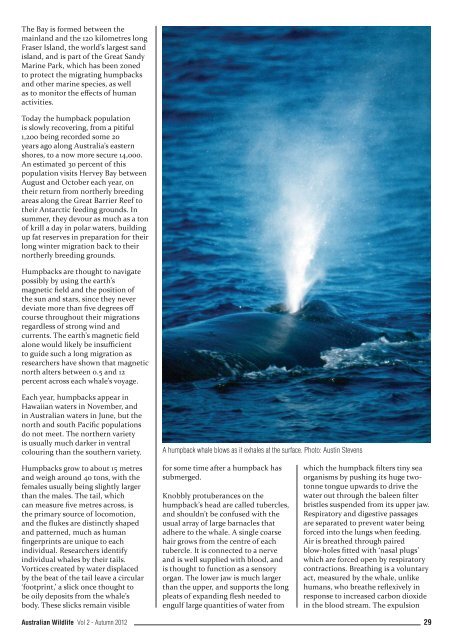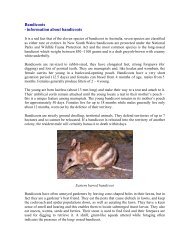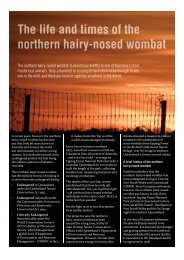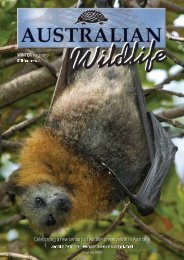Wildlife Preservation Autumn 2012.indd - Wildlife Protection Society ...
Wildlife Preservation Autumn 2012.indd - Wildlife Protection Society ...
Wildlife Preservation Autumn 2012.indd - Wildlife Protection Society ...
Create successful ePaper yourself
Turn your PDF publications into a flip-book with our unique Google optimized e-Paper software.
The Bay is formed between the<br />
mainland and the 120 kilometres long<br />
Fraser Island, the world’s largest sand<br />
island, and is part of the Great Sandy<br />
Marine Park, which has been zoned<br />
to protect the migrating humpbacks<br />
and other marine species, as well<br />
as to monitor the e ects of human<br />
activities.<br />
Today the humpback population<br />
is slowly recovering, from a pitiful<br />
1,200 being recorded some 20<br />
years ago along Australia’s eastern<br />
shores, to a now more secure 14,000.<br />
An estimated 30 percent of this<br />
population visits Hervey Bay between<br />
August and October each year, on<br />
their return from northerly breeding<br />
areas along the Great Barrier Reef to<br />
their Antarctic feeding grounds. In<br />
summer, they devour as much as a ton<br />
of krill a day in polar waters, building<br />
up fat reserves in preparation for their<br />
long winter migration back to their<br />
northerly breeding grounds.<br />
Humpbacks are thought to navigate<br />
possibly by using the earth’s<br />
magnetic eld and the position of<br />
the sun and stars, since they never<br />
deviate more than ve degrees o<br />
course throughout their migrations<br />
regardless of strong wind and<br />
currents. The earth’s magnetic eld<br />
alone would likely be insu cient<br />
to guide such a long migration as<br />
researchers have shown that magnetic<br />
north alters between 0.5 and 12<br />
percent across each whale’s voyage.<br />
Each year, humpbacks appear in<br />
Hawaiian waters in November, and<br />
in Australian waters in June, but the<br />
north and south Paci c populations<br />
do not meet. The northern variety<br />
is usually much darker in ventral<br />
colouring than the southern variety.<br />
Humpbacks grow to about 15 metres<br />
and weigh around 40 tons, with the<br />
females usually being slightly larger<br />
than the males. The tail, which<br />
can measure ve metres across, is<br />
the primary source of locomotion,<br />
and the ukes are distinctly shaped<br />
and patterned, much as human<br />
ngerprints are unique to each<br />
individual. Researchers identify<br />
individual whales by their tails.<br />
Vortices created by water displaced<br />
by the beat of the tail leave a circular<br />
‘footprint,’ a slick once thought to<br />
be oily deposits from the whale’s<br />
body. These slicks remain visible<br />
Australian <strong>Wildlife</strong> Vol 2 - <strong>Autumn</strong> 2012<br />
A humpback whale blows as it exhales at the surface. Photo: Austin Stevens<br />
for some time after a humpback has<br />
submerged.<br />
Knobbly protuberances on the<br />
humpback’s head are called tubercles,<br />
and shouldn’t be confused with the<br />
usual array of large barnacles that<br />
adhere to the whale. A single coarse<br />
hair grows from the centre of each<br />
tubercle. It is connected to a nerve<br />
and is well supplied with blood, and<br />
is thought to function as a sensory<br />
organ. The lower jaw is much larger<br />
than the upper, and supports the long<br />
pleats of expanding esh needed to<br />
engulf large quantities of water from<br />
which the humpback lters tiny sea<br />
organisms by pushing its huge twotonne<br />
tongue upwards to drive the<br />
water out through the baleen lter<br />
bristles suspended from its upper jaw.<br />
Respiratory and digestive passages<br />
are separated to prevent water being<br />
forced into the lungs when feeding.<br />
Air is breathed through paired<br />
blow-holes tted with ‘nasal plugs’<br />
which are forced open by respiratory<br />
contractions. Breathing is a voluntary<br />
act, measured by the whale, unlike<br />
humans, who breathe re exively in<br />
response to increased carbon dioxide<br />
in the blood stream. The expulsion<br />
29





